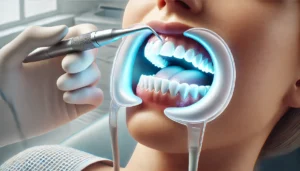Cavity vs Stain: Essential Guide to Identification and Care
When it comes to maintaining a healthy smile, understanding the difference between cavity or tooth decay and tooth stains is vital. Tooth decay can lead to significant dental issues, while tooth stains primarily affect the appearance of your teeth. In this guide, we’ll explore how to identify, treat, and prevent both conditions, ensuring you maintain optimal oral health.
Understanding Tooth Decay and Tooth Enamel Stains
Tooth Decay: Tooth decay, also known as cavities, occurs when plaque bacteria break down sugars in your diet, producing acids that erode tooth enamel. A tooth cavity is a permanent damage that can worsen if not treated. This process can result in visible holes, tooth pain, and, if left untreated, more serious cavities that impact the inner layers of your teeth. Tooth enamel naturally wears over time, which can make teeth more susceptible to damage.
Tooth Stains: Tooth stains, on the other hand, are discolorations that affect the surface of your teeth. Various factors can cause a tooth stain and affect the tooth’s appearance. They can range from extrinsic stains caused by dietary choices like drinking sugary beverages, coffee, or wine to intrinsic stains, which affect the entire tooth due to factors such as aging or medication use. Intrinsic stains may require more invasive treatments.
Causes of Cavities and Stains
Causes of Cavities
- Plaque bacteria feed on sugary and acidic foods, creating acids that erode the tooth enamel naturally.
- Poor oral hygiene habits, including irregular brushing and flossing, contribute to cavity formation.
- Consuming sugary foods and beverages exacerbates the risk of developing cavities, especially in the early stages of cavity formation.
Causes of Stains
- Extrinsic Stains: These surface stains are often caused by smoking, drinking sugary beverages, and consuming acidic foods. Tooth staining can result from various factors such as medications, aging, and dietary habits.
- Intrinsic Stains: These affect the entire tooth and are caused by medication use, genetics, or too much fluoride exposure.
- Tartar buildup from poor dental hygiene can also lead to stained teeth and discoloration.
Identifying Cavities and Stains
Symptoms of Cavities
- Tooth sensitivity or tooth pain when eating hot or cold foods.
- Visible holes on the tooth surface or near the gum line.
- Pain when biting or chewing, indicating an affected tooth. Cavities tend to worsen over time if untreated, leading to more invasive treatments.
Appearance of Stains
- Stained Teeth: Discolorations ranging from yellow to brown stain the tooth surface. Various factors can cause teeth stains and affect the surface of the teeth.
- Intrinsic Stains Affect the inner layers of teeth and often require professional whitening treatments to remove. When multiple teeth exhibit discoloration, it is more likely a stain rather than a cavity.
- Extrinsic Stains: These are surface stains that can be addressed with whitening toothpaste or professional cleaning.
Symptoms of Cavities
Cavities can exhibit a range of symptoms, making it crucial to recognize them early for prompt treatment. Common symptoms include:
- Tooth pain or sensitivity: You may experience discomfort or sharp pain, especially when consuming hot or cold foods and drinks.
- Visible holes or markings: Cavities often manifest as visible holes or dark spots on the tooth surface.
- Tooth discoloration: Affected teeth may show signs of discoloration, ranging from white spots to brown or black stains.
- Sensitivity to sweet or sour tastes: Cavities can cause heightened sensitivity to sugary or acidic foods.
- Pain when biting or chewing: If you feel pain while eating, it could indicate a cavity affecting the tooth structure.
If you experience any of these symptoms, it’s essential to schedule an appointment with your dentist as soon as possible to determine the cause and receive proper treatment.
Appearance of Tooth Stains
Tooth stains can appear in various forms, each with distinct characteristics and causes:
- Surface stains: These are visible stains on the surface of the tooth, often caused by extrinsic factors such as food, drinks, or smoking. Common culprits include coffee, tea, red wine, and tobacco.
- Intrinsic stains: These stains occur within the tooth and are often caused by internal factors such as demineralization, dental fluorosis, or certain medications. Intrinsic stains can be more challenging to remove and may require professional treatments.
- Yellow or brown discoloration: This type of discoloration can result from a combination of extrinsic and intrinsic factors, including poor oral hygiene, consumption of sugary and acidic foods, and the natural aging process.
- White or gray spots: These spots can be caused by fluorosis or other conditions that affect the tooth enamel, leading to uneven coloration.
Understanding the type of stain you have can help determine the most effective treatment method.
Examinations and Diagnoses
Regular dental check-ups are essential for identifying both cavities and stains. Early detection of a tooth cavity can prevent more serious dental issues. A dental professional may use visual examinations, X-rays, or other diagnostic tools to detect tooth discoloration or early stages of cavity formation. Scheduling regular dental cleanings helps maintain oral health and prevent major dental problems. Proper oral hygiene at home complements these professional efforts.

Treatment and Prevention
Cavity Treatments
- Fillings or root canals are common options to treat cavities depending on severity.
- Treating a tooth cavity early can prevent the need for more invasive procedures.
- Fluoride toothpaste can help remineralize tooth enamel and prevent tooth decay.
- Dental crowns may be recommended for extensive decay.
- Treat cavities early to avoid more invasive treatments like extractions.
Treatment for Stains
- Professional whitening treatments are effective at removing surface stains.
- Intrinsic stains may require more invasive treatments such as veneers or bonding.
- Whitening toothpaste and whitening strips can also help remove surface stains. Removing surface stains regularly can maintain a bright smile.
Prevention Tips
- Practice good oral hygiene by brushing and flossing regularly. Using fluoride toothpaste helps protect tooth enamel.
- Limit sugary and acidic foods to protect tooth enamel.
- Visit your dentist regularly for professional cleanings and exams. Scheduling regular dental cleanings ensures the removal of plaque bacteria and tartar buildup.
Treatment for Cavities
Treatment for cavities depends on the severity of the decay. Your dentist will assess the extent of the damage and recommend the best course of action:
- Fillings: A common treatment for cavities, where the decayed portion of the tooth is removed and replaced with a filling material. This helps restore the tooth’s function and appearance.
- Crowns: A crown is a cap that covers the entire tooth. It is often used to repair a tooth that has been severely damaged by decay. Crowns provide strength and protection to the compromised tooth.
- Root canals: When decay reaches the inner layers of the tooth, a root canal may be necessary. This procedure involves removing the infected pulp, cleaning the root canals, and sealing them to prevent further infection.
Early detection and treatment of cavities can prevent more invasive procedures and preserve your dental health.
Treatment for Tooth Stains
Treatment for tooth stains varies based on the type and severity of the stain. Options range from at-home solutions to professional treatments:
- Whitening toothpaste: Using whitening toothpaste can help remove surface stains and improve the overall appearance of your teeth. These toothpastes contain mild abrasives and whitening agents that polish the tooth surface.
- Professional whitening treatments: For more dramatic results, professional whitening treatments are highly effective. These treatments use stronger whitening agents and specialized equipment to achieve a brighter smile.
- Dental bonding: Dental bonding involves applying a resin to the surface of the tooth to cover stains and improve the tooth’s appearance. This method is particularly useful for intrinsic stains that are resistant to whitening treatments.
By choosing the appropriate treatment, you can effectively address tooth stains and maintain a bright, healthy smile.
Common Questions and Concerns about Tooth Sensitivity
What is the difference between a cavity and a stain? A cavity or tooth decay damages the tooth’s structure, while a stain only affects its color.
Can tooth stains turn into cavities? Tooth stains do not directly cause cavities but may indicate weakened enamel susceptible to tooth decay.
How can I prevent tooth decay and stains? Maintain proper oral hygiene, avoid sugary foods and acidic foods, and schedule regular dental cleanings.
What are the symptoms of a cavity or stain? Cavities cause tooth pain and sensitivity, while stains lead to tooth discoloration.
Conclusion
Understanding the distinction between cavity or tooth decay and tooth stains is key to maintaining a healthy, beautiful smile. Treat cavities promptly with cavity treatments and address stained teeth with professional whitening treatments. By practicing good oral hygiene and visiting your dentist regularly, you can prevent tooth decay and remove surface stains effectively.


